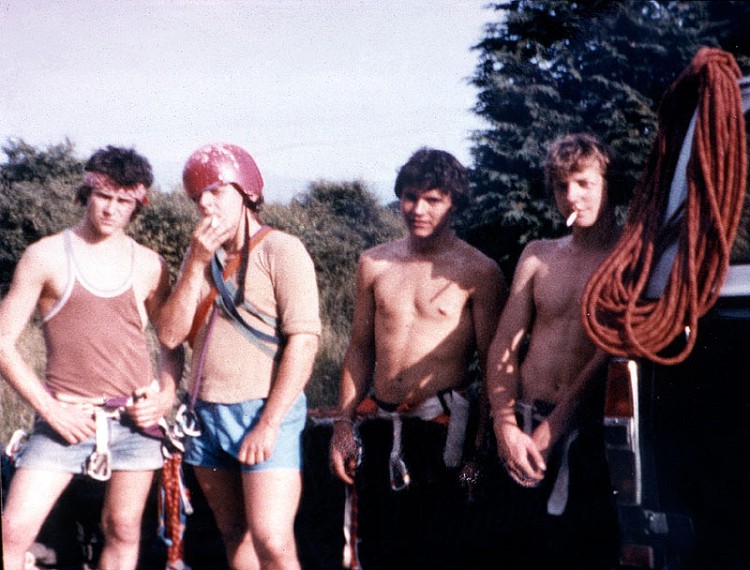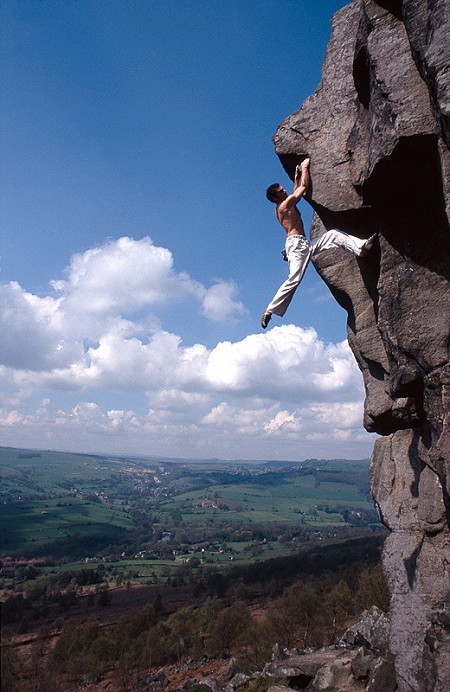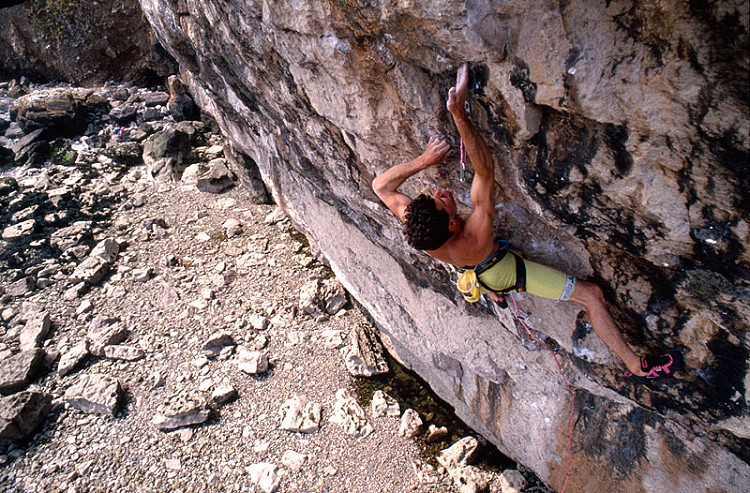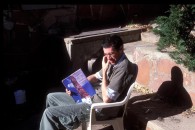
Vertebrate Publishing are pleased to announce that Jerry Moffatt's biography Revelations will be available from the end of January. Signed copies can pre-ordered now from the Vertebrate Publishing website.
The book is scheduled for release on the 26th January and is available to pre-order NOW.
- Jerrymoffatt.com is live and features short excerpts from the book and pages from Jerry's diary.
- You can view more info and buy the book on the Vertebrate Publishing website: www.v-outdoor.co.uk

Master's Wall
(An edited excerpt taken from 'Jerry Moffatt – Revelations'
© Jerry Moffatt/Niall Grimes 2009.)
The traditions of climbing in Britain stretch back over a hundred years, and if there was one cliff that represented the very heart of those traditions, it was Clogwyn Du'r Arddu on the flanks of Snowdon in North Wales.
Right in the centre of the cliff is a slab of rock, a full rope-length high, and two hundred feet wide, known as Great Wall. It is the centrepiece of Cloggy. In the 1950s, Joe Brown – the Master – had tried to climb a crack on the left-hand side of the wall. At the time Joe's personal ethics allowed him to place no more than two pegs in a pitch, so when he got to the halfway point having already placed his two pegs, he decided to retreat and leave the route incomplete. Pegs are tricky things. Metal spikes hammered into cracks and used as aid or protection damage the rock the way nuts don't. They also tend to be left in place, so they change the nature of the rock and of the challenge it presents. In Brown's day, nuts were still rudimentary or non-existent, so pegs were more logical. But despite this, Joe left the challenge for future generations.
That only made the legend of Joe Brown all the greater and the Master's Wall more tempting. In the early 1960s, Pete Crew abseiled down the route and inserted tiny pebbles into the crack above Brown's high point. Before nuts, climbers would rely on pebbles that they carried in their pockets, fiddled into the cracks. They would then thread string behind the pebbles and clip their ropes into the string. This would be their protection on these enormous, difficult routes. By comparison, Brown hadn't abseiled the climb. He merely had a pocket-full of pebbles, hoping somehow to find the right pebble for the right place as he went. Thanks to Crew's tactics, he was able to climb the line that Brown had failed on, using the threaded pebbles both for protection and for aid. The wall had become known as Master's Wall in honour of Brown's effort, but Crew called his climb Great Wall. Time moved on and Great Wall became a popular classic. People began to look towards the big, blank, crack-less expanse of rock on the right side of the huge slab.
John Redhead was one of the major characters in the North Wales scene at the time. When Andy and I were young, Redhead was one of the climbers we thought was cool. He often wore a red neckerchief, so we both got a neckerchief. I wore mine every day for a year, until it eventually rotted off my neck. Redhead had a reputation for being a wild character, and for his routes being totally mad, although from climbing with him, the thing that impressed me was how shrewd and prepared he was about things. I once saw him, prior to a first ascent, abseil down a route and mark with chalk where the crucial footholds were, or the exact spot where a piece of protection might fit. I had never seen that done before. The practice shocked me when I first saw it, but it wasn't long before I used it myself.
Redhead started to give the great, unclimbed wall at Cloggy some serious attention. Without cracks, the line, a long, near-featureless slab, was very thin on protection. What there was – tiny nuts, buried half-in, half-out of poxy cracks – gave only the hope of security, and the line just screamed danger. He gave the route some very brave attempts. Once, he got very high, but gripped with terror, retreated off a tiny skyhook, a curled metal claw, sitting precariously on a flake of rock. John lowered seventy feet back to the ground with all his weight hanging from this marginal protection. Another time, he got even higher, only to take a huge fall, rag-dolling down the slab, somehow being held by one of the tiny nuts. As if to draw a line under his efforts, Redhead abseiled down the wall, drilled a hole in the rock and placed an expansion bolt runner at his high point. He gave the climbing up to this bolt a name – The Tormented Ejaculation.
It seemed wrong to put bolts into mountain rock. Bolts are a way of protecting blank sections that could not be protected in any other way, but were only used on some kinds of limestone, not in the mountains or on gritstone. That was the ethic then and still is. That was generally accepted. Bolts had no place on Cloggy. To prove the point I decided I would go up there myself and try the route without the bolt.


I had a rest day and decided to climb the route the next day. My Fire rock boots were by now getting old and badly worn, so I sat them out in the sun all day as I relaxed by the lake below the cliff in the hope that the heat would shrink them a little, to make them feel more snug on my feet. The following day, I walked back up to the cliff with Paul Williams. Paul was a local climbing enthusiast who had also belayed Redhead on some of his attempts. I was in good company. I warmed up, went round to the top of the crag and abseiled down the wall, removing Redhead's bolt. At the base of the route, I pulled the abseil ropes back to the ground, watched them tumble down the hundred and fifty feet of wall and land, crumpling at my feet.
Quietly, in the shadow of the wall, I clipped the few pieces of protection to my harness, tied into the ropes and slipped on my boots. I breathed deeply, emptied my mind and stepped onto the rock. I climbed up the wall for thirty feet and placed a good nut. From here, I traversed right towards a line of flakes. I had cast my eye over these on abseil, but as the climbing didn't look too hard, I never gave them much attention. I got there on the lead and started moving up them. Suddenly it all started getting a lot harder than I had anticipated. I lay-backed higher up the flakes and was soon a long way above the one good nut. I began to feel totally out of control. My feet smeared on little holds I hadn't taken the trouble to clean fully while my fingers crimped desperately on barely-adequate flakes. By now, I was facing a monster fall, perhaps even hitting the ground. I carried on, terrified.
I got to the footholds below the crux and threw my weight onto them, taking some strain off my pumped arms. I wriggled the nuts into the cracks. I stood there, panting, with my body leant against the rock. I could feel my heart thumping against the wall. I gave the nuts a gentle tug to make sure they were seated properly and had a final think about lowering off. But I rationalised that if I ever wanted to do this route, and I did, then I would have to climb that section again, and I knew I never wanted to do that. So. Think. The next moves were the crux. I had looked at them properly on abseil and had a good idea of how to do them. The route was there for the taking. I tried to relax, recovered my breath, got my mind to the place it needed to be and made the decision. I set off. Almost automatically, the crux moves flowed by, relatively in control compared to the lower section. I climbed smoothly, moving up and rightwards to a crack on the right side of the wall where I could finally place another good nut. My relief was incredible. From here a final fifty feet of climbing led up and left. This top section was hard and still terrifying – it would have been possible to take a hundred foot fall down the slab – but the knowledge that I wouldn't hit the ground made all the difference, and I scraped my way to the top.
In a notebook in the famous Llanberis climbers' café, Pete's Eats, I recorded the climb, and Paul Williams came up with a name for it, De Torquemada, the leader of the Spanish Inquisition. I wasn't bothered what it was called, but nobody else liked the name. Just like Ulysses had already been named before it was climbed, so too had the Cloggy line, and the traditional name had to stay – Master's Wall, in honour of Joe Brown's attempts on it twenty-five years earlier.


Jerry Moffatt
Published this month is Jerry Moffatt's autobiography. A force in world rock climbing in the 1980s and 1990s, Jerry not only dominated the crags at home in the UK, with cutting edge routes such as Master's Wall and Liquid Ambar, he took his talent and drive to the crags of France, Germany and the USA, repeating the hardest routes in fine style and establishing harder routes of his own. His ability to travel and perform away from home, across a range of climbing disciplines that included the competition circuit, has led many to regard him as the greatest rock climber ever.
This is a first-hand account of what it takes to be the best: the ups and downs, the extraordinary level of dedication to training and climbing, the iconic characters of the time (Wolfgang Gullich, Kurt Albert, Ron Kauk, John Bachar, Ben Moon, Jean Baptiste Tribout – legends in their own right) that Jerry climbed with and with whom he wrote rock climbing history.
As Jerry travelled, the story travels with him. To the gritstone outcrops and limestone dales of the Peak District, the mountain crags and limestone cliffs of North Wales, the south of France, the Frankenjura in Germany, Yosemite, Joshua Tree and Colorado in the USA, Africa and Australia – all major stops in a climbing career littered with cutting edge first ascents and lightning-quick repeats of local testpieces.
- ARTICLE: Stanage - A Journey Through the Grades 1 Jan
- ARTICLE: My Map of the World 11 Jul, 2024
- ARTICLE: The Edge of Time 14 Feb, 2024
- GEAR NEWS: Boulder Britain 2020: Bigger, Better, BOULDER! 20 Oct, 2020
- PODCAST: Jam Crack Podcast 6 Dec, 2016
- The Pitter-Potter of Giant Feet: 'Meeting' Dean Potter 20 May, 2015
- REVIEW: Roca Verde Climbing Guide 28 Jul, 2014
- Coming Home for Christmas 24 Dec, 2011
- A New Guidebook: Boulder Britain 22 Nov, 2011
- King Of The Crag 10 Sep, 2011








Comments